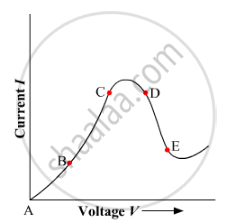Advertisements
Advertisements
प्रश्न
The graph between V and I for a conductor is a straight line passing through the origin.
Which law is illustrated by such a graph?
उत्तर
Ohm's law states that the graph between V and I for a conductor is a straight line passing through the origin.
APPEARS IN
संबंधित प्रश्न
Graph showing the variation of current versus voltage for a material Ga As is shown in the figure. Identify the region of
(i) negative resistance
(ii) where Ohm's law is obeyed.

Is Ohm’s law universally applicable for all conducting elements? If not, give examples of elements which do not obey Ohm’s law.
An electrical bulb is marked 200V, 100W. Calculate the electrical resistance of its filament. If five such
bulbs are connected in series to a 200V supply, how much current will flow through them?
What is the necessary condition for a conductor to obey Ohm’s law?
A car bulb connected to a 12 volt battery draws 2 A current when glowing. What is the resistance of the filament of the bulb? Will the resistance be more same or less when the bulb is not glowing?
State and define Ohm’s law.
State Ohm’s law? How can it be verified experimentally? Does it hold good under all conditions? Comment.
Ohm's law deals with the relationship between ______
State Ohm's Law. Represent it mathematically.

Vinita and Ahmed demonstrated a circuit that operates the two headlights and the two sidelights of a car, in their school exhibition. Based on their demonstrated circuit, answer the following questions.
- State what happens when switch A is connected to:
a) Position 2
b) Position 3 - Find the potential difference across each lamp when lit.
- Calculate the current.
a) in each 12 Ω lamp when lit.
b) In each 4 Ω lamp when lit.
OR - Show, with calculations, which type of lamp, 4.0 Ω or 12 Ω, has the higher power.
